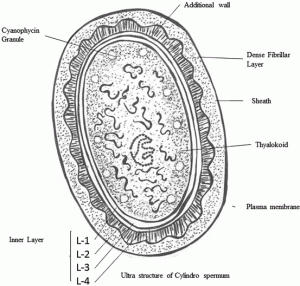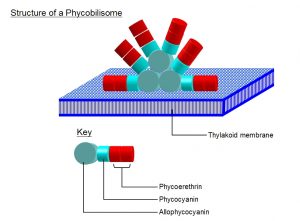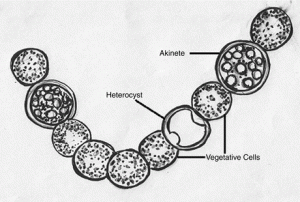Class: Cyanophyceae
General Characteristics
- Cyanophycea exhibits a prokaryotic cell organisation.
- It is the oldest oxygenic photoautotrophs on the earth
- It is commonly known as blue-green algae as their principle pigment is bluish-green ie. C- phycocyanin
- It consists of photosynthetic pigments including chlorophyll a, chlorophyll b or d (some may have), accessory pigments phycobiliprotein.
- They may be unicellular or multicellular, free-living or colonial unbranched filamentous or branched filamentous, heterocystous or non-heterocystous, aquatic or terrestrial
- They don’t have well-organized cell organelle and their pigments throughout the peripheral cytoplasm.
- They have the primitive type of nucleus ie. they lack nuclear membrane and nucleolus.
- Also, they do not have flagella and their movement is by gliding movement
- They also lack sexual reproduction
- Cyanophyceae can also contaminate surface water supplies mostly during warm summer months. The toxic component is microcystin, which gives the water a moldy, musty, grassy, or septic-tank odour.

Blue Green Algae
Cell structure
Sheath
- It is covered by a hygroscopic mucilaginous sheath which provides protection to the cell
- The nature and consistency of the sheath is influenced by the environment
- it protects cells from drying
Cell wall
- A double-layered rigid cell wall is present under the sheath providing shape to the cell.
- The inner layer is made of mucopeptide and muramic acid.
- It consists of 4 layers (LI, LII, LIII, LIV)
- The second (L-II) layer has mainly peptidoglycan and first (L-I) lie next to plasmalemma. The cell wall in both is composed of mucopeptide together with carbohydrates, amino acids and fatty acids.
- The cell wall is quite similar to gram-negative bacteria

Plasma Membrane
- The bilayer plasma- membrane is present beneath the cell wall and is called plasmalemma
- It is selectively permeable and encloses the cytoplasm
Photosynthetic Apparatus
- Pigments are present which are embedded within the lamella known as thylakoids (double-membrane structure)
- They appear as elongated, flattened sacs consisting of two unit membranes
- Adjacent thylakoids are separated from each other by a space of 50 nm, occupied by contiguous rows of discoidal phycobilisomes that transfer light energy to photosystem II reaction centers like chlorophyll b, c, d.
- The basic subunit of a phycobilisome consists of apoproteins α and β, each of which is attached to a chromophore
- α and β are attached to phycocyanin in the outer rods whereas the core of the phycobilisome α and β are attached to allophycocyanins
- Phycobilins are major light-harvesting pigments present in Cyanophyceae
- they have 4 phycobiliproteins
- c- phycocyanin (λmax- 620nm)
- allophycocyanin (λmax- 650nm)
- c- phycoerythrin (λmax- 565nm)
- phycoerythrocyanin (λmax- 568nm)
- All cyanobacteria contain the first two pigments whereas the last occurs only in few species.

Cytoplasmic Inclusions
- Plasma-membrane surrounds various inclusions like the cynophycian granules, Polyhedral bodies, Polyphosphate bodies, Polyglucoside bodies, Poly – beta-hydroxybutyric acid
- Cyanophycin is consisting of a restricted number of amino acids, that is synthesized by a nonribosomal synthetase and it serves as a nitrogen reservoir.
- Carboxysomes (polyhedral bodies) contain the carbon dioxide-fixing enzyme (RUBISCO)
- Polyphosphate granules are synthesised for both energy and phosphate storage and are degraded to produce nucleotide triphosphate or phosphate.
- Polyglucoside bodies – These are known to function in blasting the cell and play a role in buoyancy regulation.
- Poly – beta-hydroxybutyric acid is biopolymer found exclusively in prokaryotes in which it acts as a storage and is also used as proplastic e.g., Spirulina and Nostoc muscorum
Gas Vacuoles
- They are made of protein cylinders which are hollow packets cylinders consisting of metabolic gases and function as gas vesicles
- Gas vacuoles appear as bright, refractile areas in the cells.
- Cyanobacteria gas vacuoles are found most commonly in the truly planktonic forms that grow freely suspended in lakes and are responsible for buoying them to the water surface
- This it helps cells moving upward, towards the light, where which helps in photosynthesis
Nucleoplasm
- Nucleolus and nuclear envelope are absent
- DNA present inside the cytosol made up of lots of threadlike fibres or filaments and is in the centre of the cell
Habitat
- Cyanobacteria are highly diverse and are found almost everywhere including ponds, lakes, rivers, oceans, temperate soils, geothermal waters, desert soils, rocks, polar regions, brackish habitats and hypersaline waters.
- The freshwater cyanobacterial species can grow from 0 °C under the ice to 26–35 °C in the tropical zone.
- The thermophilic cyanobacteria may resist up to 45 °C or more
- The soil is the best terrestrial cyanobacterial habitat as light, humidity, temperature; nutrient and pH are easily available for their growth.
- Cyanobacteria are capable of independent existence in various environments but they also form a symbiotic association with an extensive variety of plants and animals e.g., with algae (diatoms), fungi (lichens), bryophytes ( Anthroceros ), pteridophytes ( Azolla fonds ) etc.
Special Cells
- Aknites
- Heterocysts
- Hormogonia
1.Aknites
- Akinetes function as an asexual resting state that is capable of resisting harsh environments
and later can germinate to form new cells when conditions improve. - This consist of storage compound such as glycogen & proteins
2.Heterocysts
- These are modified vegetative cells
- This helps in nitrogen fixation
- It is multilayered and present outside the cell wall
3.Hormogonia
- This consists of gliding motility and many hormogonia also produce gas vacuoles which provide buoyancy to the cell

Reproduction
- Cyanophyceae follows the vegetative and asexual mode of reproduction. Vegetative reproduction includes cell division, fragmentation and hormogonia formation.
- Unicellular cynophyceae follow binary fission, while filamentous multicellular forms and colonial forms exhibit disintegrate and later mature into new individuals
Economic Importance
- Cyanobacteria are used in photoproduction of biofuels, NH 3 scrubbing of excess atmospheric greenhouse gases including CO 2, production of various secondary metabolites, vitamins, toxins, cosmetics, dairy products, food-grade dyes and other therapeutic substances.
Hazards of blue-green algae
- A few species of blue-green algae, such as Microcystis, Aphanizomenon, and Anabaena, produce toxins capable of causing illness in humans and animals.
- These toxins can cause gastroenteritis, neurological disorders, and possibly cancer.
- Occasionally, the rapid increase in their production may lead to cyanobacterial blooms which lead to destruction of many marine species
- Toxins like Cyanotoxins are produced by BGA.
References
- https://www.sciencedirect.com/topics/agricultural-and-biological-sciences/cyanophyceae
- https://link.springer.com/chapter/10.1007/978-3-662-13187-9_10
- https://www.sciencedirect.com/topics/chemistry/poly-beta-hydroxybutyrate
- https://www.sciencedirect.com/science/article/pii/S2211926419302188?dgcid=rss_sd_all
- https://www.sciencedirect.com/topics/earth-and-planetary-sciences/blue-green-algae
